Old Louisville History
Things To Learn
Welcome to Old Louisville
History of Old Louisville
1850 to Present
Southern Exposition
History of St. James Court
Architectural Styles
Walking Tours
Design Competition

On August 13, 2012 the South Fourth Street Association, in Old Louisville, Kentucky, announced the Fountain Court Entrance Design Competition. The goal was to create a new entrance to Fountain Court (a walking court at 1430 1/2 S. Fourth Street). The new design is planned to replace the current brick and iron entrance, while recognizing the legacy of the Southern Exposition.
The competition was composed of three phases. First phase: A qualifying portfolio was submitted. Second phase: A call-back for an interview, for up to ten designers, to submit their proposed ideas to the jury. Third phase: Three designers would be selected by the jury to prepare a 2 x 3' display board for final judging. The three designers selected would each receive $500 for their efforts. The First Place winner of the competition would receive an additional $500.

Old Louisville neighbor and graphic designer John Paul entered the competition (download the portfolio here), and made it through the Second Phase and tied for Third Place. After a second vote, John Paul was choosen to receive an unannounced $100 stipend for his efforts and was awarded Fourth Place.
The next step was to show the winners’ Display Boards to the public at the 2012 St. James Art Show for an informal vote.
And The Beat Goes On
An unrelenting obsession is my passion and desire to share information and educate people about the Old Louisville neighborhood, I will continue to present my Fountain Court Design Proposal, and try to connect with an entity that may someday make these ideas a reality.
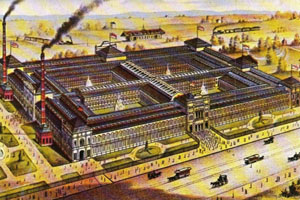
Instead of a monument I propose a learning experience, a way to tell the whole story of Old Louisville, not just a tribute to the Southern Exposition, and beautifing the entryway at Fourth St. and Fountain Ct. and Fourth St., and not stop at the alley, but go all the way to St. James Court and the St. James Fountain, and also include the entire block of St. James Court bounded by Magnolia, 6th, and Hill Streets.
I believe my plan can also meet these objectives:
• Enhance property owners’ pride in the neighborhood, up and down 4th St., and on both sides of Fountain Court.
• Provide an attractive pedestrian park connector for the Fourth St. and St. James Court neighborhoods, which could increase property values.
• Encourage pedestrians to enter Fountain Court and tour St. James and Belgravia Courts;
• Promote the appreciation and preservation of our culture and heritage.
• Offer a safe and accessible opportunity for people to engage and learn about our neighborhood’s history.
• Provide a location for the Fourth St. utility connections that are needed for Art Show weekend.
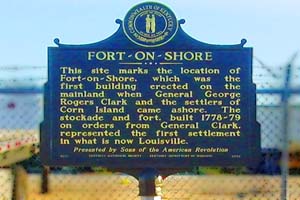
I propose that a Kentucky Historical Marker be installed by the KY Dept. of Highways at this site and for it to become the anchor of this project. The marker would be Old Louisville’s new tribute to the Southern Exposition.
A much bigger story could be told. Old Louisville lacks a central interpretive/educational venue. The Old Louisville Information Center and the Old Louisville Visitors Center both miss the opportunity to thoroughly inform visitors about the neighborhood’s history of the Southern Exposition, St. James Court. and Old Louisvllle.
I propose, that instead of just a “monument”, we create an outdoor interpretive space, and call it Fountain Court Park.
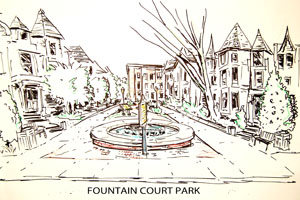
This would be the opportunity to tell the whole story, and present a broad picture of Old Louisville’s history, so in addition to the four years of the Southern Expo, I propose we use this space to display our neighborhood’s history from 1850 to today. Doing so with interpretive signage, in a way that history lessons at Fort Nelson Park (W. Main St.), the new Freedom Park (Cardinal Blvd @ 2nd and 3rd), and on the Louisville Loop are now being told.
Interpretive signage could be used along Fountain Court Park to highlight and educate visitors about the significant cultural and historic features of the Southern Exposition, St. James Ct. and the Old Louisville Preservation District.

• The interpretive signage would include both graphic and written components to communicate a desired message.
• The interpretive signs would be located so that those viewing the signage do not interfere with thru traffic on the walking court.
• Interpretive signage could be included in several different types of signs. Pole-mounted panels could be two-sided, and mounted around the entire perimeter of the Southern Exposition property, from 4th to 6th, and from Magnolia to Hill, above the reach of most vandals.
• The post mounted signage has a protective Lexan sign face that can be cleaned or replaced, and those would be placed in a park like setting in the greenway of Fountain Court.
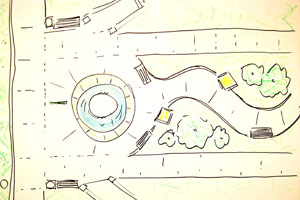
Panel topics could include:
• Welcome to Old Louisville
• History of Old Louisville
• 1850 to Present
• Southern Exposition
• History of St. James Court
• Architectural Styles
• Map of the streets/courts on the Expo property as it is today to encourage walking tours.
Interpretive signage becomes part of a three-dimensional exhibit space, which is where the landscape design aspect comes in. This is done with walkways, seating, and landscaping to make a simple inviting, comfortable, and attractive area for neighbors and visitors to relax.
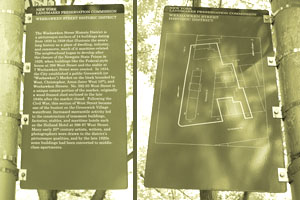
The learning experience is ongoing with social media.
facebook.com/OldLouisville
A Fountain Court Park Facebook Page continues to attract and educated people on the subject of the Southern Exposition, and Old Louisville, so that the learning experience doesn’t end when a visitor leaves.
Why would we want to expand this project beyond just a Southern Exposition tribute?
Because no one else has proposed this idea, and no one else might. It is our civic duty to take advantage of the situation, and this opportunity, to honor all of our neighborhood’s known history.
Instead of just a monument, we can create a learning experience.
Contact me to learn more.
The following is a unedited outline of many of the topics that many visitors may be interested in.
The neighborhood known as Old Louisville is approximately 1200 acres immediately south of the city’s central business district, containing two local Preservation Districts, and such a diversity of persons and activities that it constitutes a “city within a city” community. An early residential area of the city, Old Louisville experienced a later physical decline that has been reversed in the last 50 years as more and more people have been attracted to its historical and architectural significance, its geographical proximity to the business and government center of Louisville, and its rising community spirit.
Development of Old Louisville began in the 1830’s. The earliest homes in the neighborhood were country residences. North-south avenues were extended across Broadway from the city proper in the 1850’s, and mule-drawn carts were extended out Fourth Street to Oak by 1865. IN 1868, the city's boundaries were extended south to the present site of the University of Louisville's Belknap Campus, thus formally incorporating the Old Louisville area into the city limits.
Following the Civil War, Louisville experienced a tremendous surge of growth and prosperity. In Old Louisville, the single most dramatic stimulus for expansion was the Southern Exposition of 1883. The exposition's main exhibit hall covered the area between what is now Magnolia Avenue (formerly Victoria Place) and Hill from Fourth to Sixth Streets, a single enclosure 900 by 600 feet in size. Following the close of the Exposition in 1887, the structures were dismantled and the site parceled off to developers who constructed St. James and Belgravia Courts.
Several aspects of Old Louisville architecture are significant. First, a variety of styles ranging from the formal, symmetrical designs of Renaissance Revival to the romance of Queen Anne and Chateauesque, can be viewed within a one or two block area. Second, a diversity of colors, materials and scale abound in the residences here. Three-story homes along Third and Fourth Streets are the largest and most elaborate, followed by those in St. James Court, Ormsby, and Second Street.
Moving farther west and east, the houses become smaller and less elaborate. Along Sixth Street to the west, and Brook and Floyd Streets to the east, one and two story frame houses begin to replace the large limestone and brick residences. Smaller row houses can also be seen in Old Louisville, including a number of carriage houses converted to private residences. A variety of dwelling types, including some early experiments in apartment buildings and duplexes, can also be seen.
As you walk through Old Louisville, keep in mind that many buildings contain bits and pieces from many architectural styles. This eclecticism makes Old Louisville very unique and picturesque. The houses are meant to evoke an emotional response from the viewer and are best appreciated from the sidewalk rather than a drive-by down the street. Houses in Old Louisville are not lifeless museum pieces, but rather homes and offices of people living and working in a thriving neighborhood. Take your time and enjoy the tours.
Top
The neighborhood known as Old Louisville is approximately 1200 acres immediately south of Louisville Metros central business district, containing three National Register Districts and such a diversity of persons and activities that it constitutes a city within a city community. An early residential area of the City, Old Louisville experienced a physical decline that has been reversed. In the past several years as more and more people have been attracted to its historical and architectural significance, its geographical proximity to the business and government center of Louisville Metro, and its rising community spirit.
Development of Old Louisville began in the 1830s. The earliest homes in the neighborhood were country residences. North-South avenues were extended across Broadway from the city proper in the 1850s, and mule-drawn cars were extended out Fourth Street to Oak by 1865. In 1868, the citys boundaries were extended south to the present site of the University of Louisvilles Belknap Campus, thus formally incorporating the Old Louisville area into the city limits.
Following the Civil War, Louisville experienced a tremendous surge of growth and prosperity. In Old Louisville, the single most dramatic stimulus for expansion was the Southern Exposition of 1883. The expositions main exhibit hall covered the area between what is now Magnolia Avenue and Hill from Fourth to Sixth Streets, a single enclosure 900 by 600 feet. Following the close of the Exposition in 1887, the structures were dismantled and the site parceled off to developers who constructed St. James and Belgravia Courts.
Top
Southern Extension
Wealthy citizens of the city began developing Old Louisville during the mid-nineteenth century. Extending the city grid south of Broadway, the new neighborhood became Louisville's first suburb. Aptly called the Southern Extension, the community initially consisted of a few country residences occupied by Louisville's business and political leaders. More families began to build homes in the area after the extension of north-south avenues in 1850.
Development slowed with the onset of the Civil War, but quickened its pace in the post-war years as the economy boomed. Louisville's growth as a manufacturing center created a rising professional and managerial class in search of upscale housing. Within the next twenty years, many of these families built substantial two and three-story brick houses along the streets between Broadway and Ormsby Avenue.
Rural Area Annexed
As development moved southward, so did the city's boundaries. In 1868, the city annexed the land encompassing the House of Refuge, now the Belknap Campus of the University of Louisville. At that time, the House of Refuge stood in a rural landscape on the periphery of existing neighborhoods. Much of the surrounding area remained rural for the next decade, until the period of growth inspired by the Southern Exposition.
Exposition Fever
Between 1883-1887, one million people visited the Southern Exposition, an industrial and mercantile show located within Old Louisville. Opened by President Chester A. Arthur and featuring Thomas Edison's light bulb, the Exposition brought national attention to Louisville. For local residents, it also sparked great interest in the surrounding neighborhood. At the close of the Exposition, developers bought and sub-divided the 45-acre site. For the next two decades, houses were built with increasing frequency along Third and Fourth Streets, between Park and Lee Streets. St. James Court was begun in 1890.
Additional subdivisions begun soon after included Belgravia Court, Confederate Place, Fountain Court, Avery Place, Ormsby Place, and Ouerbacker Court. Houses constructed during this period were built of brick and stone in the revival styles popular during the Victorian era.
Falling Out Of Favor
Old Louisville remained one of the city's most fashionable neighborhoods through the turn of the century. By the beginning of World War I, however, the once popular neighborhood began to lose favor. Families became enamored of the suburbs developing east and west of the city. First, the electric streetcar and then automobiles made the new suburbs easily accessible. Improved electric, plumbing, and heating technology made the new suburban homes more attractive.
As families moved out, businesses moved into the neighborhood. From the 1920s through the 1950s, commercial development pressure dramatically altered the character of Old Louisville. Businesses destroyed a substantial number of homes to make room for growing building and parking needs. Between 1950 and 1970, the neighborhood lost more homeowners as families sought new housing in the growing suburbs.The population dropped from 36,000 to 17,900 people.
Citizens Take Action
Deeply troubled by the changes that had swept through the neighborhood, residents took action. In 1961, a lawyer and a newspaper reporter formed Restoration, Inc. for the purpose of buying and renovating historic homes in Old Louisville. Not only did the small company renovate eleven homes on Belgravia Court; it also inspired others to do the same. Soon new homeowners had purchased and begun rehabilitating houses in Belgravia and St. James Court.
Five area churches organized the Neighborhood Development Corporation in 1968, sustaining local activism. Homeowners, tenants, and community leaders worked together to rezone the area, prohibit commercial use in residential neighborhoods, and renovate houses. In support of these efforts, the city gave historic Old Louisville official status and protection by designating it a local Preservation District in 1974.
Today, the quality of life in Old Louisville is maintained through the efforts of organizations like the Old Louisville Neighborhood Council, Property Improvement Committee, a dozen or so different neighborhood associations, and the Historic Landmarks and Preservation Districts Commission, all active participants in the Neighborhood Council.
Top
"From Seed to Loom" - 1883-1887
August 1, 1883 President Chester A. Arthur opened the Southern Exposition of "Art, Industry, and Agriculture".
The 40 acre grounds extended from Park Ave. to Hill St. and from 4th to 6th Streets.
The two-story 600 x 900' wooden main building by McDonald Bros. and Curtin Architects was on the present site of St. James, Fountain, and Belgravia Courts.
The art gallery and promenade were in Central Park. The marvel of the exposition was the lighting of 4500 Edison incandescent light bulbs each night.
The Southern Exposition
August 1, 1883 President Chester A. Arthur opened the Southern Exposition, an industrial and mercantile show of art, industry, and agriculture, titled From Seed to Loom.
The 45 acre grounds extended from Park Ave. to Hill St. and from 4th to 6th Streets. The show was open for 100 days a year for four years and attracted one million visitors.
A two-story 600 x 900 foot wood-frame main building was on the present site of St. James, Fountain, and Belgravia Courts. An art gallery and promenade were in the Central Park area.
The marvel of the exposition was the lighting of 4500 Thomas Edison incandescent light bulbs each night.
Central Park
Central Park was first developed for public use in the 1870s and was known as DuPont Square since it was at the time part of the DuPont family estate.
In 1904, the DuPont family sold the park to the city of Louisville for $297,500. The city enlisted famed architect Frederick Law Olmsted, the man who designed New York City's Central Park and had already designed an entire park and parkway system for Louisville, to plot the new park. The DuPont farmhouse estate was demolished.
Olmsted designed a large open air shelter with a colonnade built on top of the hill where the DuPont country house and later the art museum had once stood, along with a wading pool and athletic fields on the side. The original walking trails were kept in place. The entire park was originally fenced in.
In the 1970s the open air shelter was enclosed and used to house a police substation and the Old Louisville Information Center, a neighborhood meeting space. In 2012 The windows of the OLIC were reopened and glassed in.
An amphitheater and wooden playhouse were built in 1976. The new playhouse is used to host the free annual summer performances of William Shakespeare's works, which has been held in the park since 1960. In 1988 the name was changed to Kentucky Shakespeare Festival.
St. James Court
After the Southern Exposition closed and disassembled in 1887, the area was purchased at auction by Mr. William H. Slaughter in 1888 , who then subdivided it into building lots. He formed the Victoria Land Company through which the lots were sold.
The Fountain
Mr. Slaughter designed St. James Court to include the center greens and a fountain, which he ordered from England.
When the Strand Theater on Chestnut Street was demolished, the grill work from the balcony was purchased for $180 and installed around the fountain. It was another one of the first projects paid for by Art Show profits (more on that later).
Other early improvement projects included grading of the Center Greens and installation of concrete curbs around them (before that people often parked cars on the greens).
In the early 1970s the original fountain was dismantled after years of repairs had been made and had failed.
The fountain was recast in bronze by Fine Arts Sculpture Centre in Clarkson, Michigan. The project took three years and the new fountain, with a newly sculpted central figure (the original was broken while dismantling it) was dedicated on September 14th, 1975.
In 2010, the basin of the fountain was re-poured after the previous one had decayed beyond repair, at a cost of over $25,000.
The Lions and Urns
The lion at the south end of the court is one of four originals Mr. Slaughter choose to guard the entrances of Victoria Place (now called Magnolia).
There were two lions at the 4th St. entrance that stood erect, and two at 6th St. that were lying down. The two standing lions had their tails damaged repeatedly and the lions eventually disappeared, presumably for scrap.
The two remaining lions were moved to guard each end of the central court. The lion on the north end was destroyed by a tree in 2011. One cast-iron lion was stolen in 1968 and later found "far out in the country" after extensive media coverage.
The two cast-iron urns on the greens were a gift from a former president of the neighborhood association. They always have had red geraniums planted in them as a tradition of the court.
Gas Lamps
The 20 gas lamps on the courts were another one of the early improvements made by the neighborhood association and were added in 1965. They required the proceeds from four Art Shows to pay for them.
The Conrad-Caldwell House Museum
The magnificent Richardsonian mansion at 1402 St. James Court is the finest in the city. Also known as Conrad's Castle, the Conrad-Caldwell House is one of the most stunning of Old Louisville's houses and defines Richardsonian Romanesque architecture.
The house was built for Theophilus Conrad, a Frenchman (Alsace) who made his fortune in the tanning business. The original construction price was $75,000.
The Caldwell family purchased it in 1905 after Mr. Conrad's death and lived there for 35 years. It served as the Rose Anna Hughes Presbyterian Retirement Home for 40 years.
The St. James Court Historic Foundation purchased the home in 1987, restored it, and operates the museum today. Walk around and enjoy its gargoyles, swags, massive arches and fleur-de-lis.
The interior features breathtaking woodwork, stained glass and fixtures. It is the only historic home open for tours in Old Louisville.
The Art Show
The St. James Court Art Show is a juried fine arts and fine crafts show held the first weekend of October. The show began in 1957 as neighborhood artists displayed art on a clothesline in the center court, and has turned into one of the biggest and best in the nation, attracting the largest crowds of any event in Kentucky, including the Kentucky Derby.
The St. James Court Neighborhood Association
The second oldest neighborhood association operating in the USA, oversees the operation of the various organizations of the court, including the Foundation, the Art Show, and the Museum.
Without their endless hours and decades of volunteer work, the preservation and upkeep of this neighborhood would never have been possible.
Top
The word "Victorian" refers to the reign of England's Queen Victoria, 1837-1901. More generally, it refers to the the second half of the nineteenth century. In the U.S., some historians use the term to describe the period after the Civil war until World War I in 1914.
The Industrial Revolution which occurred in England in the first half of the 19th century brought major changes in occupations (farming to factories) , population distribution (farms to towns and cities), economics (burgeoning middle class) and values, Major social changes are accompanied by new major problems. One that developed in this era - pollution due to the use of soft coal as the main energy source - is one we are still grappling with.
The same kind of developments in England in the first half of the century occurred in the US during the second half of the century.
One typical reaction to important societal changes is to yearn for the past, what some might call the Camelot Syndrome. In England, in terms of architecture, this meant returning to its simpler roots as a country during the Middle Ages; hence, Gothic Revival. This "revival" would be followed by others. America followed the same path.
There is no one Victorian style, bur rather a number grouped together under the Victorian heading: Victorian Architecture in the U.S.
The first American style broad-based style of architecture after the Revolutionary War was Federal (1790-1830) which was English Georgian style with an American name. This was followed by Greek Revival (1820-1860). These styles were based on Classical Greek and Roman models. Then the influence of the Industrial Revolution became important and the Victorian era reaction took place.
The primary Victorian styles and their origins are as follows:
* Gothic Revival - English Middle Ages, i.e., the Tudor dynasty
* Italianate - Rural Italy
• Second Empire - French Baroque Revival during Napoleon III's reign
• Stick - Alpine architecture
• Queen Anne - 17th century England
• Richardsonian Romanesque - American adaptation of Romanesque style
• Shingle - American return to English Colonial style in the New World where forests were easily accessible for building
• Colonial Revival - H. H. Richardson-inspired examination of American roots in New England
• Renaissance - not to be confused with the Second Renaissance Revival, a Beaux Arts substyle
Top
There are four basic walking tours of Old Louisville, first developed and published in the 1960s, and have changed very little over the years.
Old Louisville Central Park North Tour
This tour includes many magnificent homes, with much variety, built over many decades.
Starting at the Conrad-Caldwell House go west on Magnolia Ave., cross Sixth St., turn left, and walk south along the west side of Sixth St. The tour begins at 1412 S. 6th St.
Turn around and proceed north to Park Ave. along 6th St. Turn left onto Park, proceed and then turn around returning to 6th St., then turn left.
Halfway down the block turn left into the walking court Floral Terrace, proceed to the end of the court and turn around to return to 6th St.
Turn left and continue north on 6th St. to cross Ormsby Ave. to 1244 6th St. then cross 6th St. to walk on the north side of Ormsby.
At the intersection of Garvin Pl. turn left, proceeding north, past the Garvin Gate, turn right and walk east to see 430 Oak St., on the corner, then turn around and proceed back to Ormsby and turn left.
At 4th St. turn right and proceed back to Central Park Ave. to conclude the tour.
Allow at least an hour to walk this tour. The walking court can't be enjoyed from a vehicle, so walking is the best option.
Old Lou. Central Park South Tour
This is the most recommended of the four tours and should be enjoyed while walking, allowing at least one hour for the tour.
To begin the tour park on Magnolia Ave. at St. James Ct. and stop at the historic marker at the head of the courtyard in front of the Conrad-Caldwell House Museum.
The Southern Exposition of 1883 covered approximately 40 acres, which included what is now Central Park and St. James, Belgravia, and Fountain Courts.
William H. Slaughter bought the area south of Central Park after the Exposition closed in 1887 and formed the Victoria Land Company, which subdivided the land, created the green spaces, and sold the lots.
Slaughter designed the center greens and ordered the fountain and lions. The two resting lions at each end of the Court were to guard Magnolia (then called Victoria Place) at Sixth Street.
The tour continues down the west side of St. James Ct. to Belgravia Ct. Turn right, walk to 6th St. and then return on the otherside of Belgravia Court to 4th St.
Turn right on 4th, cross 4th St. at Hill. Turn left on 4th and proceed past Magnolia towards Ormsby. Cross the street and return down the west side of 4th St., past Park Ave, Central Park, and Magnolia, back to Belgravia Ct. then turn right into the court and then turn right on east St. James Ct. before returning to the start of the tour.
Old Louisville Third St. Tour
The tour of Millionaires Row - 3rd Street from Ormsby Ave. to Hill St., and back is the second most popular walking tour in Old Louisville. It is best enjoyed walking, though it can be seen while bicycling or driving.
The tour begins at the Filson Historical Society, 1310 S. 3rd St., and heads south on the west side of the street.
At the Hill Street intersection, cross 3rd St., then head north along the other side of 3rd St.
The tour ends back at Ormsby Ave.
Old Louisville East Tour
The east side of Old Louisville features older and somewhat smaller homes for the neighborhood, when compared to 3rd St. or St. James Ct., 2nd St. is a very attractive tree-lined, one-way thoroughfare that stretches from the University of Louisville north, towards the Ohio River bridge into Indiana. The homes on 1st St are different than those on 2nd St., so the tour returns on this route.
This walking tour begins near the Old Louisville Visitors Center at 218 Oak St. and travels south on 2nd towards Magnolia Ave.
At Magnolia Ave, turn left, proceed to First St, turn left, then walk north back towards Oak St, or to include a visit to Ouerbacker Court, continue on Magnolia Ave., past 1st St. to the court entrance, return to 1st St. and turn right, proceeding north.
The tour ends at the intersection of Oak and 1st Streets. Turn left to return to your starting point.
Top
Content on this page is free to copy and use for Old Louisville promotional purpose only.
john paul, Oct. 2012 ~